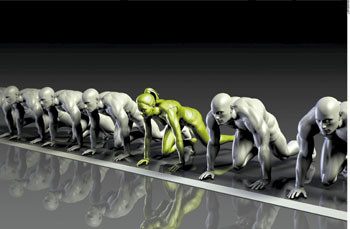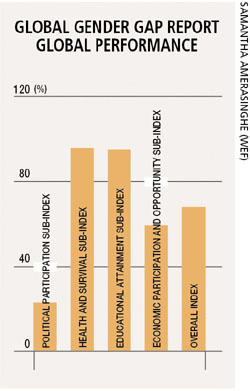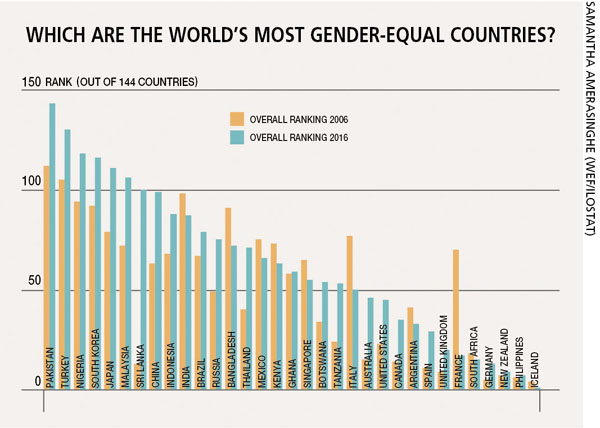GENDER PARITY
CLOSING THE GLOBAL GENDER GAP
Samantha Amerasinghe notes that tech disruption may threaten women’s jobs

Narrowing the gender gap can be a significant driver of growth for economies over the coming years. World Bank estimates suggest that closing the gender gap could add US$ 1.2 trillion to US GDP by 2020 and China could see a US$ 2.5 trillion increase in output over the same period.
The transformative power of technology could be a key driver, pointing to a future with new opportunities and limitless possibilities. But for women in particular, this new technology also poses a threat.
Why might that be?
Technology has the ability to narrow the industry gender gap but risks exacerbating existing inequalities as most jobs that women hold might be displaced. Many of the jobs that females hold are likely to be the hardest hit by the coming age of technological disruption – known as the Fourth Industrial Revolution.
How disruptive this technological revolution might be to the progress of women in the labour force and in closing the gender gap is a question that continues to be at the centre of extensive policy debate and discussion.
Undoubtedly, technology has its benefits. Household work could be further automated, allowing women to return to the workforce while changes to what have traditionally been men’s roles in the workforce may also reshape the division of duties at home. In this way, we may see a narrowing of the industry gender gap.

But as disruptive change takes hold, many jobs might be displaced and there is a risk that new work trends might exacerbate existing gender inequalities. Women stand to lose, as they’re less likely than men to be working in areas where tech adoption will create jobs.
The World Economic Forum’s The Future of Jobs Report finds that occupations with the largest share of female employees such as office and administrative roles – in general, jobs that are concentrated in areas that can be automated fairly easily – are most at risk. But it also alludes to jobs in manufacturing and production with the largest gender gap being affected.
A perfect storm of technological trends like mobile internet, cloud technology, big data and the Internet of Things ((IoT) have the potential to make such roles redundant as large workforces may no longer be necessary, which would result in job losses in these areas.
Disruptive technologies including the rise of robots and artificial intelligence (AI) will result in a net loss of 5.1 million jobs by 2020 in 15 of the world’s largest economies. Together, these countries account for 65 percent of the global workforce, and include Brazil, China, India, Japan, South Africa, Turkey, the UK and the US.
The weight of expected job losses over the 2015 to 2020 period due to disruptive technological change falls almost equally on women (48%) and men (52%). This in itself suggests a widening gender gap in the workforce as females make up a smaller share of it to begin with.
In absolute terms, men stand to gain one job for every three lost while women will face more than five losses for every job gained.

According to the report, some of these job losses could partially be offset by job creation in STEM-based roles in areas such as computing, maths, architecture and engineering. But growth in these new and emerging roles is far outpacing the rate at which women are entering such jobs.
In male-dominated STEM-based roles, there is a huge disparity between women and men.
Females are expected to gain only one new STEM job for every 20 that are lost from technological disruption. On the other hand, men are set to gain nearly one new STEM job for every four jobs lost.
Clearly, if current gender gap trends persist, women are at risk of losing out on the best opportunities in the employment market.
The global slowdown in closing the gender gap can be partly explained by the drop in female labour force participation. The global average for women is 54 percent compared to 81 percent for men.
Sri Lanka has made slow progress in closing the gender gap in labour force participation. By 2030, the country’s gender gap – measured by the International Labour Organization (ILO) as the difference between women’s and men’s labour force participation rates – is projected to reach 31 percentage points versus China (12.7%), the US (9.2%) and the UK (6.8%).

Women are under-represented in fast-growing STEM jobs. Based on current trends, this suggests a worsening gender gap over time.
The slow rate of progress in increasing female labour force participation has heightened the urgency for women to enter higher-growth areas that require STEM skills. Expanding access to secondary and higher education – with an emphasis on STEM – will be critical if we’re to see improvements in the quality of work for women.
Better access to education should enable females to enter higher growth areas that require STEM skills, and improve their standing in the economic opportunity and participation index, which is a key focus area to achieve gender parity.



